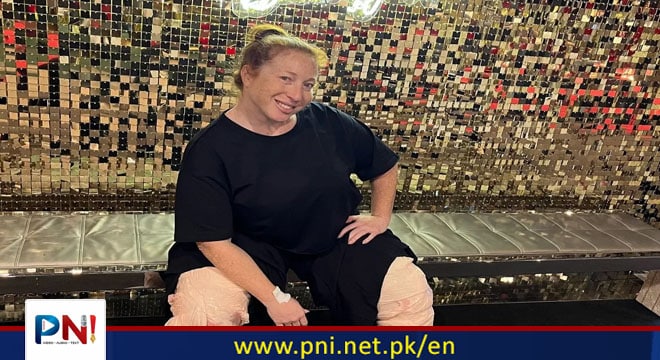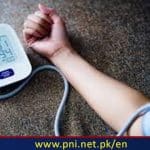ISLAMABAD, Jan 15 (Online|): Dancing on social media helped Allison Jacobs celebrate her body as she recovered from an eating disorder. It’s also where she learned about lipedema.
Growing up, Allison Jacobs knew her body looked different.
“I was always a thicker child, and it was confusing to my parents because I didn’t eat differently,” Jacobs, 41, of Tampa, Florida, tells TODAY.com. “I had really muscular thighs. … They were getting bigger and very (out) of proportion to my torso.”
Throughout her life, doctors told her to lose weight, but it didn’t seem to change how her body looked. Then someone on social media told her about lipedema, a condition where people develop abnormal deposits of fat tissue under their skin, according to the Lipedema Foundation. Eventually, she was diagnosed with it.
“I was so shocked that I had gone my whole life, and no one ever brought this up,” she says. “There was such a focus on my body. I was going to doctors at such a young age, doing diets at such a young age, and it’s like, ‘How come nobody knew about this?’”
Jacobs has started undergoing surgery to treat her lipedema and shares her journey on social media to educate others about the under-recognized condition.
“(I) want people to know about lipedema and about all of the things that come along with the disease,” she says. “I want people to understand the emotional roller coaster that goes along with the disease.”
Unusual weight gain leads to pain
As a child, Jacobs started dancing, and that meant there was “a lot of focus on (her) body at a very young age,” she recalls. Her thighs developed in such a way that they seemed disproportionate to the rest of her body. She always noticed how much volume she had around her knees. Sadly, others spotted it as well, and in middle school a boy taunted her by asking, “Where are your knees?”
“I stopped wearing shorts,” Jacobs says. “The onset (around puberty) is at the worst time in a female’s life. … You’re always comparing yourself and looking at other people.”
Doctors told her to lose weight. But it didn’t work. This cycle continued throughout childhood and into adulthood.
“Even at my thinnest, my legs were always just big,” she says. “Throughout trying to lose that weight, eating disorders developed, mental health (worsened), like severe depression. … I was in a really bad place for a really long time.”
By the end of 2019, she was in recovery for her eating disorder and resumed dancing again. She started sharing it on social media to celebrate her body. Soon followers asked if she had lipedema, and she began researching it. She asked her doctors about it.
“They didn’t know what it was,” Jacobs says. “They looked at me like I was crazy.”
After some research, she found Dr. David Amron, a lipedema specialist in Beverly Hills, California. Jacobs made a virtual appointment to learn more about lipedema.
“I just wanted to know about the disease,” she recalls. “He did diagnose me. He’s like, ‘You absolutely have it.’”
At the time, Jacobs didn’t experience much of the pain that can come with lipedema, so she wanted to understand other treatment options before surgery. She spoke with her other doctors, including her vascular surgeon, who’d treated her for deep vein thrombosis. Again, they didn’t seem to know what lipedema was or acknowledge she could have it. This led to a relapse of her eating disorder.
“It made me think that this wasn’t a real disease,” she says. “I was confused and frustrated.”
Soon, she began experiencing more pain. At first, her knees made it difficult for her to spin when she danced. Then walking through the theme parks with her children caused her hips, knees and ankles to ache.
“It was because of the disproportionate weight caused by the lipedema and the pressure on my joints,” she says. “All of this stuff was so normalized because I have only lived in my body. I only have my lived experience.”
Jacobs soon realized that she would need to undergo surgery. While excited, she also felt overwhelmed knowing she would have to fly across country and recover in a hotel while her two children stayed at home.
“It’s daunting,” she says. “I’m also very excited. … I can’t wait to feel what it’s like to dance again.”
Lipedema and its treatment
Early in his career, Amron, a dermatologic surgeon, began focusing his practice on tumescent liposuction, a type of surgery where patients do not undergo general anesthesia for the procedure, so it’s considered “safer,” he says. Other doctors began referring difficult cases to him where patients needed liposuction on their calves and ankles. That’s when he began looking into lipedema.
“Lipedema is a fat-storage disease that’s very under-recognized around the world,” Amron, who founded Advanced Lipedema Treatment, tells TODAY.com. “It will typically begin presenting right around puberty or the teenage years. It does affect about 10% of the population with varying degrees, and it progressively almost always gets worse in a person’s lifetime.”
Armon says that while it was identified in the 1940s, it has become “forgotten.” Very few doctors know about it because it’s lumped together with other fat-storage conditions during medical school. Lipedema occurs more often in women than men, and its onset coincides at a time where children feel more self-conscious about appearances.
“For the most part, it’s pretty much unresponsive to diet and exercise, and people learn that. They … lose weight and diet and eat less and exercise more and it doesn’t change,” he says. “Adolescents and young girls are commonly shamed and blamed. They develop a lot of guilt and many have eating disorders because of it.”
There are stages of lipedema from one to four, with one being the least severe and four being the most. While it doesn’t seem to shorten one’s lifespan, it does impact quality of life.
“It begins to affect mobility,” Amron says. “I would say that 35% of patients that I see for consultations have had orthopedic surgery, orthopedic issues, because of all the congestion around the joints.”
Amron feels encouraged that more research into lipedema has started over the past decade and hopes that this will better help patients. Ideally, he hopes that doctors become more aware of this condition so they can diagnose it when patients are younger.
“We need to really be diagnosing it early, in the teenage years,” Amron says. “And starting on preventative measures and those things primarily revolve around compression therapy, compression garments to prevent the swelling.”
Liposuction is the “ultimate treatment for lipedema.”
“There’s specific considerations for the more advanced patients, but it involves typically a series of strategic surgeries in patients to target exactly where the lipedema is in specific ways,” he says. “Your average patient needs between two and three surgeries for complete correction.”
Lipedema “very rarely comes back after the surgeries,” he adds. While many insurances do not cover the costs of the procedures, Amron says some recently have offered to pay for it.
For Amron, seeing the mental transformation of his patients feels rewarding. “It’s a really emotional journey for these patients,” he says. “I see something every day that hits me.”
Life after her first surgery
In the middle of December, Jacobs underwent her first surgery and Amron removed 8.2 liters of tissue from Jacobs’ thighs.
“It blows my mind,” she says.
The early days of recovery felt tough. The procedure was out-patient, so afterward, she and her husband stayed in a hotel. She needed to wear compression garments unless her bandages were being changed, which could be extremely painful.
Her first post-surgical shower took a scary turn when she passed out, which can happen due to shifting fluid in the body and lack of compression. Her husband watched as her eyes rolled into the back of her head, and she became unresponsive. But Jacobs knew that fainting could happen, so she had her husband with her the entire time during early recovery, as was recommended. Luckily, it never happened again.
Around day 10, Jacobs felt more like herself. “I was walking better,” she says. “The pain was much better.”
As part of her recovery, Jacobs underwent lymphatic drainage massage, a type of light massage that encourages the lymphatic system to move, and that helps her still as she heals. Grappling with how her body has changed has been challenging at times.
After working for years to love and appreciate her body, she says she’s now wondering, “How do I love and appreciate this body without thinking that the other both was less than?” she says. “It’s like I was cheating on my old body.”
She can tell that her knees have changed. She no longer has pain, and she sees that her pants don’t cling to them like they once did.
“My body showed up every single day and it still shows up for me through this recovery,” she says. “I’ve just become even more appreciative of my body.”
Jacobs has danced since her surgery and feels impressed by how much more agile she is after just one procedure. She looks forward to seeing how much more she can move after her upcoming two surgeries. The next procedure will focus on removing tissue from her torso and pelvic girdle and the last one will be her calves and arms.
Jacobs feels passionate about sharing her story to help others who might be living with lipedema.
“I knew something was wrong. I knew something was different, and I was just repeatedly told over and over again that it was my fault,” she says. “To be able to share my experience and reach (others) … it’s healing my inner child.”
Follow the PNI Facebook page for the latest news and updates.








